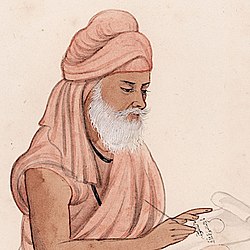Nirmala (sect)
 Painting of a Nirmala Sikh by Kapur Singh, Amritsar, ca.1860–65 | |
| Founder | |
|---|---|
| Bir Singh, Ganda Singh, Karam Singh, Ram Singh, and Saina Singh | |
| Regions with significant populations | |
| Punjab • Gangetic Plains | |
| Religions | |
| Sikhism • Hinduism (specifically Vedanta) | |
| Scriptures | |
| Guru Granth Sahib • Vedantic texts | |
| Languages | |
| Punjabi • Sanskrit |
| Part of a series on |
| Sikhism |
|---|
 |
Nirmala (
Origin
The origin of the Nirmalas is uncertain. According to Khushwant Singh and other historians, the sect is first mentioned in the Sikh literature during the Guru Gobind Singh era, in the last decade of the 17th century.
According to the Nirmalas, in 1686, Guru Gobind Singh sent five Sikhs (Bir Singh, Ganda Singh, Karam Singh, Ram Singh and Saina Singh) to Varanasi to learn Sanskrit and classical Hindu literature. This began the Nirmala tradition.[2][5] After they returned to Anandpur, they were honoured by the title Nirmala (Sanskrit for "pure" or "unsullied").[6] The Nirmalas took the Amrit initiation into the Khalsa panth.[7]
According to another account found in the late 19th-century Nirmal Panth Pardipika by the Nirmala scholar and Tat Khalsa supporter Giani Gian Singh, Guru Gobind Singh met a Sanskrit scholar named Pandit Raghunath in late 17th-century. He asked him to teach Sanskrit to Sikhs. However, Raghunath politely refused to do so, because he did not want to teach Sanskrit to Shudras.[8] So Guru Gobind Singh sent some Sikhs dressed in upper-caste attire to Varanasi, where they became accomplished scholars of Indian theology and philosophy.[8] The Pandit Raghunath-related story of Giani Gian Singh is likely ahistorical fiction.[3]
The historicity of this account has been questioned because there are very few mentions of Nirmalas before the 19th century.[3][9] Pashaura Singh and Louis E. Fenech hypothesize that the Nirmalas originated much later or may have descended from the Udasis, who are similar to them in ascetic lifestyle, celibacy and Vedantic interpretation of Sikh philosophy.[10]
History
Patronage from Sikh nobles, especially the rulers of the
Sardar Ganda Singh of
Philosophy and practices
However, compared to the Udasis, the Nirmalas have shared a closer relationship the mainstream Khalsa Sikhs. Many prominent Nirmala sants preached mainstream Sikhism in Punjab, and Nirmala akharas have played an important role in training Sikhs. But after the Akali movement, the Khalsa attempts to create a Sikh identity completely distinct from Hindus made the Khalsa-Nirmala relationship fragile.[10]
The Nirmala Sikhs wear ochre-colored/
Locations
The Sri Nirmal Panchayati Akhada or Sri Panchayati Akhada Nirmal at
.Notable Nirmalas
- Pundit Tara Singh(1822–1891), Punjabi and Sanskrit scholar
- Suraj Parkash
- Giani Gyan Singh, (1822–1921), scholar
- Balbir Singh Seechewal, prominent environmentalist
References
- ^ Nirmala: Sikhism, Encyclopaedia Britannica
- ^ ISBN 978-81-7380-722-0.
- ^ ISBN 978-81-7380-990-3.
As the Nirmalas do not seem to have been adequately mentioned in the Sikh literature before the 19th century, it is difficult to uphold the contention of Giani Gian Singh as historically true, rather it seems highly improbable.
- ^ ISBN 978-0-8108-5088-0.
- ISBN 978-81-89899-55-4.
- ISBN 9788120605763.
- ^ Kaur, Madanjit (2007). Guru Gobind Singh: Historical and Ideological Perspective. Chandigarh: Unistar Books. p. 198.
- ^ a b c d Nirmala, The Encyclopedia of Sikhism Volume III, Punjabi University, Patiala, pages 236–237
- ISBN 978-0-8108-6344-6.
- ^ ISBN 978-0-19-100412-4.
- ^ ISBN 9788126908585.
- ISBN 978-0-7914-6179-2.
- ^ ISBN 978-1-135-79760-7.
- ISBN 978-0-19-100411-7.
- ISBN 978-93-88414-12-8.
- ISBN 978-0-19-975655-1.
